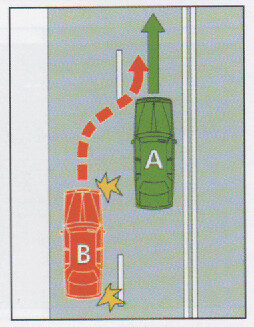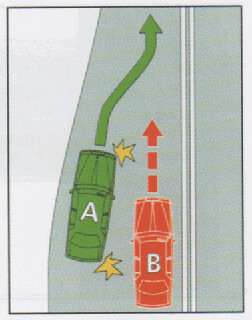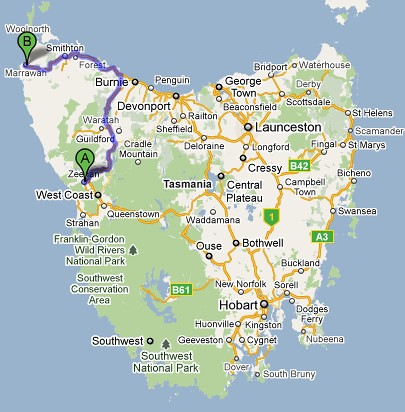Common Road Rules
Drive Left 靠左行駛
In two-way traffic, motor vehicles are operated on the left hand side of the road. Keep left at all times in two-way traffic.
在雙向行駛的交通上,車輛是靠道路的左邊行駛。任何時候都必須保持靠左行駛。
Zip/Merge Rule 車道縮減規則
When you're in a line of traffic merging with another line of traffic moving the same way, give way to any vehicle ahead of you. This sometimes means giving way to the vehicle on your left. This rule only applies where there are no lanes marked on the road.
當你行駛在要縮減的車道上時,必須禮讓任何在你前方的車輛。
這有時候表示要禮讓在你左方的車輛。(如果不懂可以看下方的補充)
此規則只適用在「沒有車道標示」的道路上。
Addtional Information About Merge Rule
關於車道縮減規則的補充資訊 (有圖例說明,較容易瞭解)
Merging rules and laws seem to still be confusing for SA drivers. Who gives way? Who signals where and when?
A good guide is to look for lines marked on the road. If you are crossing a line of any sort (See diagram 1 & 2) you must give way.
If there are no lines to cross (See diagram 3) it’s a Zip merge. Then give way to anyone on your left or right if any part of their vehicle is ahead of your vehicle.
車道縮減規則及法規對於南澳的駕駛似乎仍很困惑。誰該讓路? 誰該在何地何地打信號?
一個好的方式是查看道路上的車道標示。如果你在任何狀態下變更車道 (如圖例1及2),你必須讓路。
如果沒有車道標示 (意指你沒有車道線可跨越,如圖例3),這屬於車道縮短會車。
 |
Diagram 1 Lane change. Really simple, we all should know this one. Car B - the vehicle changing lanes - should always give way to traffic in the lane it is changing into. 圖例 1 車道變換。很簡單,我們都應該曉得的。汽車B是變換車道的車子,它應該禮讓任何在它準備變換過去車道上的車輛。 (也就是說,B必須讓A,因此應該從A的後方進入車道才是正確的) |
 |
Diagram 2 Most people understand Lane End. We've had them in SA for ever and every one knows what to do. Car B is crossing a "lane end" or "give way" line so must give way. Just make sure you don't confuse them with the Zip Merge (Diagram 3) which is totally different. 圖例 2 多數人都瞭解這是車道終止。在南澳,我們已讓所有的人都知道該怎麼做。汽車B因車道終止(或讓路標示)而要變換車道,它應該讓路。此案例與圖例3的案例是不相同的。 (重點:A跟B是行駛在不同的車道上,中間是有車道線的;因此,B必須讓A,也就是須先減速或停車,從A的後面進入車道) |
 |
Diagram 3 This is a Zip Merge. The "new" one, introduced during the year 2000. If any part of the other vehicle on your left or right is ahead of you, then you must give way. Zip Merges happen at any place two lines of traffic are forced into one line or lane and there are no lines to cross. The cars in this diagram may have just left two marked lanes or may have been in two lines of traffic on a wide un-laned road, either way, the car in front gets to go first. 圖例 3 這個就是所謂的車道縮短會車。是西元2000年之後才有的。 不管是你左方或右方的車輛,只要它們在你的前方,你就必須讓路。這種情況發生在二個車道縮短為一個車道,或是沒有車道線的車道上。 (重點:A跟B之間是沒有車道線的,假如A在B之前,則B必須讓A先行; 大部份的情形下,會禮讓左方的車子) |
Who signals? If you will be moving across into another lane or line of traffic you must signal. It's the law. It also means you have much more chance of being "let" in.
至於誰要打信號? 如果你準備切入另一個車道或另一個車流,你必須打信號。這是法律規定。這也表示你較常被讓車 (Let in 是指「讓...進來」之意)。
內容及圖片來源:Road Law & Road Rules, South Australia
Give Way 讓路
where two vehicles are converging on the same place at such speed as to risk a collision, the driver on the left must give way to the vehicle on the right UNLESS one of them is confronted with a "Give Way" sign or a "Stop" sign.
A driver facing a "Stop" sign or a "Give Way" sign must give way to all other traffic.
二輛車在相同地點會車,在某種車速之下會發生碰撞危險時,在左方的車子必須禮讓右方的車子,除非任何一方遇到了「讓路」指標或「停車」指標。
駕駛遇到「停止」或「讓路」指標時,必須禮讓任何的車輛。
Stop Sign 停止標誌
At a "Stop": sign you must bring your vehicle to a complete "stop" before entering the intersection. Also, you must give way to pedestrians who are crossing the street into which you are turning.
在「停止」標誌前,表示你必須讓你的車子在進入路口之前完全停止。同樣的,你必須禮讓在你準備轉入道路上過馬路的行人。
T-junction T字路口
At a T-junction the driver approaching the junction along the terminating road must give way to all traffic on the continuing road unless the traffic on the continuing roads is faced with a "Stop" or "Give Way" sign.
在T字路口,在道路終止的車道上的車輛,必須禮讓行進中車道的車輛,除非行進中車道的車子遇到「停止」或「讓路」標誌。
(簡單說,直行中的車子有優先權,遇到道路終止而須左轉或右轉的車子,都必須禮讓直行車先行)
Turn Left at Any Time with Care 小心左轉
Where a "Turn Left at Any Time With Care" sign is erected you may turn left at all times but you must give way to pedestrians and vehicles in the intersecting street.
當遇到「小心左轉」標誌時,你可以在任何時候左轉,但你必須禮讓路上的車子與行人。
Slip Lane 交流道
Where a slip lane is provided the vehicle using the slip lane must give way to all traffic.
在交流道上的車子必須禮讓其他的車輛。
(也就是說,你從交流道準備進入主要車道時,要讓車)
Roundabout 圓環
The give-way-to-the-right rule applies to drivers entering a roundabout. However, drivers should approach these areas at a speed that will allow others to merge safely.
禮讓右方車輛的規則,適用在準備進入圓環的車子。然而,駕駛應該將車速保持在能讓其他車子安全地進入圓環的情形下來切進圓環。
(因靠左行駛的規則,圓環是順時鐘方向行駛,圓環上正在行駛的車子會從你的右方過來)
Turning Right at an Intersection 在十字路口右轉
When turning right at an intersection you must give way to oncoming traffic which is turning to its left, unless a sign tells you otherwise. Don't turn in front of an oncoming vehicle proceeding straight ahead.
在十字路口右轉時,你必須禮讓對向的車子 (此對向車轉入它的左方),除非有其他的標誌指示。
不要在任何直行中的對向車輛之前右轉。(因直行車有優先權)
Road Surface Arrows 路面箭頭
Road Surface Arrows are an instruction to follow the directions indicated. If you're not in the correct lane for your chosen direction you can change lanes only after signalling your intention, only if it's safe to do so and only before reaching any intersection or junction. Under no circumstances may you change lanes at an intersection or junction.
路面箭頭是用來說明行駛的方向。如果你進入了錯誤行駛方向的車道,你要先打信號顯示你的意圖、確保這樣是安全的的,並且在抵達任何路口之前,才可以變更車道。無論在什麼樣的情形下,都不可以在路口進行車道的變換。
(簡單說,最好是不要逆向行駛啦,很危險的,萬一開錯方向,先打信號、確保安全,在扺達任何路口之前趕緊切回正確方向的車道)
附:塔斯馬尼亞自駕的相關資訊
Fuel 汽油燃料
Remote locations and stunning wilderness make Tasmania a remarkable destination to explore by car. Remember to fill up your tank if you are travelling long distances off the main routes, to or from the west coast, or to the far south - particularly if you are driving after about 6pm. In the north-west, no fuel is available on the Western Explorer between Marrawah and Zeehan.
偏遠的地點及漂亮的原野景色,使得塔斯馬尼亞成為一個駕車遊覽的勝地。記得將油箱加滿,如果你在主要道路以外作長途的行駛,或來往西部海岸地區,或前往較遙遠的南方地區,尤其是如果你在下午六點以後駕車。
在西北地區,Marrawah (B) 與 Zeehan (A) 之間的西部探索路段是沒有任何加油站的。

Road Types and Conditions 道路類型與環境
Throughout itineraries provided on this website, and on many road maps, you will see letters from A to C ascribed to Tasmanian roads.
- A roads are major sealed highways.
- B roads are secondary sealed roads.
- C roads are often unsealed. For example, Cockle Creek in the far south, or the Western Explorer road in the far north-west. Take extra care on these roads, and be aware that some car hire contracts have special conditions in relation to unsealed roads.
網站提供的行程表中,或是許多的道路地圖,你會看到塔斯馬尼亞的道路標示著A~C的英文字母
- A開頭的道路是主要的、有鋪柏油的快速道路
- B開頭的道路是次級的、有鋪柏油的道路
- C開頭的道路通常是未鋪柏油的。舉例來說,偏遠南方的 Cockle Creek,或是偏遠西北方的西部探索道路。在這些道路上需額外的小心,並且留意某一些汽車租用合約對於未鋪柏油道路有特殊的條款。
When estimating driving distances and times, you should always allow extra time for your journey. Roads can be winding and steep, especially on the west coast. During the winter months our highland roads around Cradle Mountain, in particular, may be snow covered but it is rare for snow tyres to be required. Contact the Cradle Mountain Parks and Wildlife Interpretation Centre at telephone: 03 6492 1110; Email:cradle@parks.tas.gov.au for road conditions.
當評估駕駛距離及時間時,你應該給你的行程預留額外的時間。道路很可能是陡坡並有強風的,尤其是在西部海岸地區。在冬季,搖籃山的高地道路特別會被雪所覆蓋,但很少會需要用到雪胎。請聯絡搖籃山公園及野生解說中心,可撥電話03-6492-1110; 或電子郵件:cradle@parks.tas.gov.au 詢問道路狀態。
Tasmania's bushland is rich in wildlife. Unfortunately, native animals have no road sense. Be very careful when driving in the early morning and at dusk.
塔斯馬尼亞的荒野地區充滿著野生動物。不幸的是,本地的動物不懂什麼是道路。當在清晨或夜晚駕車時,請特別小心。
Related Webs 相關網站
http://www.transport.tas.gov.au/
簡易道路規則測試 (practice driver knowledge test)



 留言列表
留言列表
